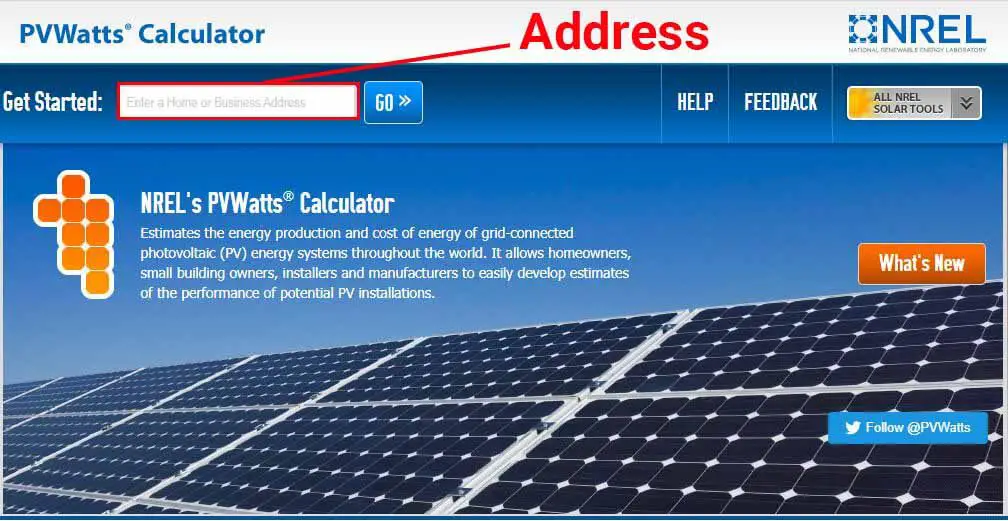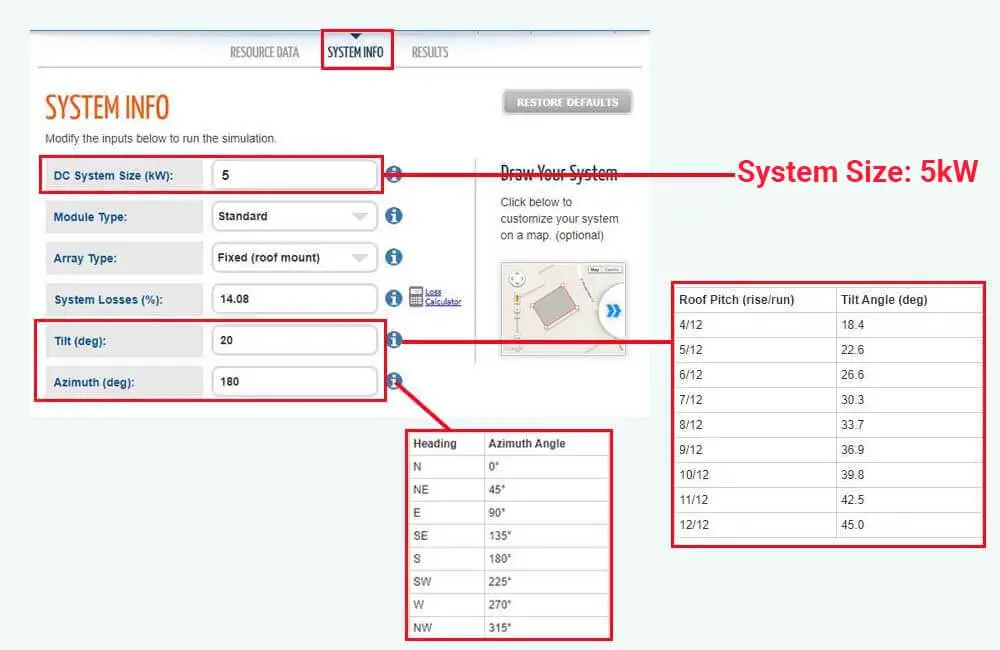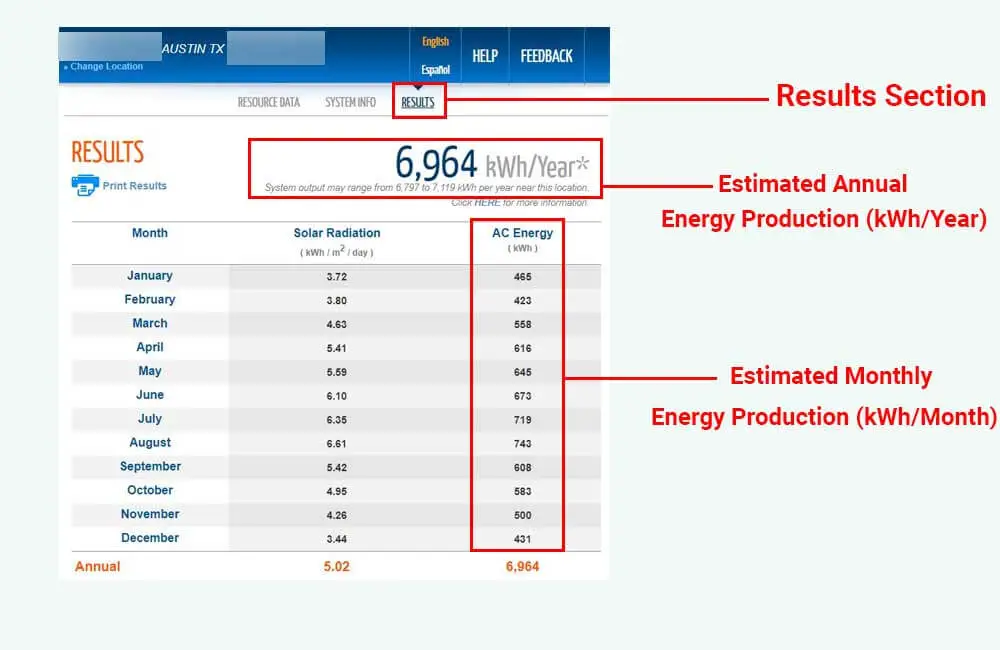The 5kW (5000 Watts) rating on a solar system means that, provided enough direct sunlight, the system could potentially produce 5000 Watts of power. But the actual amount of power that a system of this size produces is not constant and will fluctuate throughout the day.
For example, in the morning, around 8 am, a 5kW system might only produce about 300-500 Watts of power, but at noon, the system might actually produce 4000-5000 Watts.
However, that is Electrical Power in Watts (W) or kiloWatts (kW), and what really matters at the end of the day, and what utility companies charge for, is Electrical Energy in Watt-hours (Wh) or kiloWatt-hours (kWh).
In this article, I discuss the daily, monthly, and annual energy production of solar systems rated at 5kW, the factors that influence this energy production, and how you can estimate the amount of energy that a 5kW is capable of producing for you.
After reading this article, you’ll have an idea of what to expect from a 5kW solar system if you do decide to install one.
How much energy does a 5kw solar system produce?
The actual amount of energy that a 5kW solar system produces will depend on the amount of sunlight it receives, which itself depends on a few factors such as system location, the elevation of the solar panels (tilt angle), the direction the system is facing (heading), and of course, weather.
However, throughout the year, and as a rule of thumb, a 5kW solar system would – on average – produce around 20 kWh of energy per day. This translates to about 600 kWh per month, and around 7500 kWh of energy per year.
In the summer, when direct sunlight is generally abundant, a 5kW system could produce up to 35 kWh of energy in a single day. In the winter, however, the system might only produce 5 kWh of energy per day.
Here’s a table that compares the average monthly and daily energy production of a 5kW solar system in the months of June and December, in 12 different cities around the U.S.:
| City | Average Monthly Energy Production in June | Average Daily Energy Production in June | Average Monthly Energy Production in December | Average Daily Energy Production in December |
| Phoenix, Arizona | 870 kWh | 29 kWh/day | 610 kWh | 19.5 kWh/day |
| Austin, Texas | 710 kWh | 23.5 kWh/day | 490 kWh | 15.75 kWh/day |
| Tallahassee, Florida | 620 kWh | 20.5 kWh/day | 500 kWh | 16.25 kWh/day |
| Sacramento, California | 900 kWh | 30 kWh/day | 390 kWh | 12.5 kWh/day |
| Boston, Massachusetts | 650 kWh | 21.5 kWh/day | 300 kWh | 9.75 kWh/day |
| Reno, Nevada | 900 kWh | 30 kWh/day | 450 kWh | 14.5 kWh/day |
| Burlington, Vermont | 640 kWh | 21.4 kWh/day | 250 kWh | 8 kWh/day |
| Salt Lake City, Utah | 840 kWh | 28 kWh/day | 341 kWh | 11 kWh/day |
| Raleigh, North Carolina | 675 kWh | 22.5 kWh/day | 430 kWh | 13.75 kWh/day |
| Princeton, New Jersey | 680 kWh | 22.6 kWh/day | 310 kWh | 10 kWh/day |
| Santa Fe, New Mexico | 870 kWh | 29 kWh/day | 580 kWh | 18.75 kWh/day |
| Salem, Oregon | 720 kWh | 24 kWh/day | 185 kWh | 6 kWh/day |
Please note that the estimates in the table are based on the assumption that the 5kW system in these locations is facing due South, and is elevated (tilted) at an angle of 20 degrees. Below, I explain what this means.
Using your location, and a couple of other details, you can actually estimate how much energy a 5kW solar system would produce for you on a yearly, monthly, or even daily basis.
This can be done using the PVWatts Calculator, which is a free tool provided by NREL (the National Renewable Energy Laboratory).
The calculator uses historical weather data in your particular location to estimate the average amount of sunlight that your solar panels would get, which it then uses to estimate the average energy production of a solar system based on:
- The size of the system (5kW in our case)
- The elevation angle of the system (the tilt angle of the solar panels)
- The direction that the solar panels are facing (Heading or Azimuth)
- The type of solar panels used in the system
- The overall efficiency of the system
To access this energy production data, follow these steps:
Step 1: Specify the location of the system
Go to the PVWatts Calculator (here), and submit your address or the location of the 5kW solar system.

Step 2: Provide system information
After you submit the location of the system to the calculator, the next step is to go to the “System Info” section of the tool and provide some information about the system.

In the “System Info” tab, there are 6 input fields that you can modify. I recommend you only modify the following:
DC System Size (kW):
When you first go to the “System Info” tab, you’ll find that the “DC System Size (kW)” field is set to 4 by default. Since our system is rated at 5kW (5000W), make sure you enter 5.
Tilt (deg):
The value in this field corresponds to the elevation angle of your solar panels relative to the horizontal surface of the ground, or in other words the angle at which your solar panels are going to be tilted.
For example, if a solar panel is laid on a flat surface, its tilt angle is 0 degrees.
If you’re planning on installing the 5kW system on one of your roof sections, and the roof section is sloped, you can click on the information icon next to the input field to determine the equivalent of the roof pitch in degrees.
For example, if the solar panels are going to be installed on a roof section that has a 6/12 roof pitch, it means that the solar panels are going to be elevated by a 26.6-degree angle.
If you’re not sure what the roof pitch is, you can use an app such as Bubble Level for Android or Measure for iOS to determine the tilt angle of that roof section.
The angle at which a solar panel is tilted influences how much sunlight it receives, and therefore, how much energy it produces. So make sure to submit the correct tilt angle to get accurate estimates.
Azimuth (deg):
The value in this field will represent the exact heading of the solar system, or in other words, the exact direction that the system is going to be facing.
For example, an Azimuth of 90 degrees means that the solar panels are facing due East, and an Azimuth of 180 degrees means that the solar panels are facing due South.
The direction that a solar panel faces will also impact how much sunlight it receives throughout the day, and therefore, how much energy it produces. To get accurate energy production estimates, this input must also be accurate.
If you’re planning on installing the 5kW solar system on the roof, use an app such as Commander Compass Go for iOS or Azimuth Compass for Android to determine the Azimuth angle of the particular roof section.
If you haven’t yet determined which section(s) of your roof can be used to install the system, please refer to this article.
After you’ve provided the correct system size, tilt angle, and Azimuth angle to the PVWatts Calculator, the next and last step is to go to the “Results” tab and get your estimates.
Step 3: Get your estimates
Based on your inputs, in the “Results” section, the tool provides estimates of the annual and monthly energy production of the 5kW solar system.
To visualize this, I’m going to use the following example:
- Address: an address in the city of Austin, Texas.
- DC System Size: 5kW.
- Tilt: I’ll assume the system is roof-mounted with a 6/12 roof pitch, which is equivalent to a tilt angle of 26.6 degrees.
- Azimuth: I’ll assume that the only unshaded roof section available is directly facing South-East, this equates to an Azimuth of 135 degrees.
I submitted these details in the “System Info” section, and in the “Results” section, the calculator provided the following estimates:

In the image, you can see that the tool estimated that a 5kW solar system in this location, tilted at a 26.6-degree angle, and directly facing South-East (135-degree Azimuth), would on average produce 6964 kWh of energy per year.
In the table, you can also see estimates of the energy production of the system for each month. For example, our 5kW system stands to produce around 465 kWh of energy in January or 743 kWh in August.
What can a 5kW solar system run? Can it power a home?
Above, we’ve discussed how energy much a 5kW solar system would produce, but the question remains: is a 5kW solar system enough to power a house?
Well, the answer is: it depends on your energy consumption.
For perspective, and as estimated by the U.S. Energy Information Administration (EIA), the average American household consumes about 10600 kWh of energy per year, which equates to an average energy consumption of 900 kWh per month, or 30 kWh per day.
As explained above, a 5kW solar system would generally produce about 7000-7500 kWh of energy per year. In other words, a 5kW system would not be enough to offset 100% of the energy consumption of the average American home.
For the average home in the U.S., a 5kW would only offset about 60 to 80% of the energy consumption depending on the location.
For grid-tied systems, solar energy production doesn’t necessarily have to offset 100% of your energy consumption. For example, if you use 11000 kWh of energy annually, and your 5kW system produces 7500 kWh/year, your energy bill will still be reduced by about 68%.
However, for off-grid systems, the solar system has to be large enough to offset 100% of your daily energy usage.
Whether or not a 5kW system is enough to meet your daily energy requirements, will depend on the appliances you typically use throughout the day, their energy consumption, and how often or for how long you use these appliances.
So, what can a 5kW solar system run?
To provide a bit of perspective, here are some appliances, and their typical hourly energy usage in Wh/hour (1kWh/hour = 1000Wh/hour):
| Appliance | Average hourly energy consumption (Wh/hour) |
| Refrigerator | 1000 – 2000 Wh/day (50 – 100 Wh/hour) |
| Washing machine | 500 – 1200 Wh/hour |
| Microwave | 600 – 1200 Wh/hour |
| Coffee maker | 150 – 400 Wh/hour |
| TV | 40 – 200 Wh/hours |
| Desktop computer | 100 – 400 Wh/hours |
| Laptop computer | 20 – 100 Wh/hour |
| Window air conditioner (5000 BTU) | 250 – 400 Wh/hour |
| Window Air conditioner (12000 BTU) | 600 – 1000 Wh/hour |
| Central air conditioner (18000 BTU) | 800 – 1500 Wh/hour |
| Central air conditioner (24000 BTU) | 1000 – 1800 Wh/hour |
| LED light bulb | 5 – 20 Wh/hour |
| Incandescent light bulb | 25 – 100 Wh/hour |
Related topics:
How much electricity does an air conditioner use?
For example, let’s say that in your location, a 5kW would at least produce 15 kWh of energy per day, aside from extremely cloudy days. That amount of energy could run:
- A refrigerator (around 1500Wh or 1.5 kWh of energy consumption in 24 hours of run time)
- A 32″ LED TV for 6 hours (around 300 Wh or 0.3 kWh of energy consumption in 6 hours)
- 3 Laptop computers for 8 hours (around 1500 Wh or 1.5 kWh of energy consumption in 8 hours)
- 5 LED light bulbs for 8 hours (around 600 Wh or 0.6 kWh of energy consumption in 8 hours)
- A 24000 BTU (2 tons) air conditioner for 6 hours (around 9000 Wh or 9 kWh of energy consumption in 6 hours)
This is just to give you an idea.
To actually determine if a 5kW solar system is enough to run your appliances, you’ll have to list all of the appliances that you use on a typical day, their power usage (in Watts), and the amount of usage time for each appliance.
You’ll then be able to determine the daily energy usage of each appliance by multiplying the power usage (Watts) of the appliance by the amount of usage time (hours):
Daily Energy Consumption of Appliance 1 (in Watt-hours) = Power Rating of Appliance 1 (Watts) x Time (hours)
It is worth noting that even though refrigerators are left on 24 hours a day, they only really run for 1 third of that time (8 hours). So if you have refrigerators listed in your appliance, use 8 hours as their daily run time.
After you calculate the daily energy usage of each appliance, sum everything up to determine your daily energy usage:
Daily Energy Consumption (in Watt-hours) = Daily Energy Consumption of Appliance 1 + Daily Energy Consumption of Appliance 2 + Daily Energy Consumption of Appliance 3 + …
Doing this will allow you to quantify your daily energy consumption, which you can then compare to the energy production estimates of the 5kW in your location. If you’re planning on going off-grid, this is necessary.
But don’t worry, there’s an easier way to do this. You can easily determine your daily energy consumption by using our Energy consumption calculator.
The calculator allows you to list all of your appliances, their power usage, and their usage duration and then calculates the energy consumption of each appliance to determine your total energy consumption.
Click here to use the calculator.
How many solar panels do I need for a 5kw system?
You would need anywhere between 14 and 25 solar panels to make up a 5kW (5000W) solar system. The exact number of solar panels that you would need for a system of this size would depend on the power rating or wattage (Watts) of the solar panels you use.
For example, if you choose to use 250-Watt solar panels for your system, you would need 20 solar panels (5000 W ÷ 250 W = 20).
How big is a 5kw solar system?
Generally, a 5kW solar system would require between 250 and 350 sq. ft. of roof space (between 24 and 32 sq. m.) depending on the efficiency of the solar panels. The more efficient the solar panels are, the less space will be required.
For example, let’s say we use these 440W solar panels from LG which are 22.1% efficient. If we use 12 of these solar panels, we would make up a 5.28kW system (440W x 12 = 5280W).
These solar panels would each take up around 21.4 sq. ft. (2 sq. m.) of space. So for the 12 solar panels, we would need around 257 sq. ft. or 24 sq. m. of space.
Now, let’s say we chose to use these 300W solar panels from TrinaSolar, which are 18.3% efficient. If we use 17 of these solar panels, we would make up a 5.1kW solar system (300W x 17 = 5100W).
These solar panels would each take up around 17.6 sq. ft. (1.64 sq. m) of space. So for 17 of these panels, we would need around 300 sq. ft. or 28 sq. m. of space.
Notice that the system made up of the 22.1% efficient solar panels would require less space (43 sq. ft. less) and would have a higher power rating (180 more Watts).
Related:
How many solar panels will fit on my roof?
How many batteries for a 5kw solar system?
As explained above, a 5kW solar system would – on average – generate 20 kWh (or 20000 Wh) of energy per day. To be able to store and access that amount of energy, you would need – at least – 18 batteries rated at 12V-100Ah, 9 batteries rated at 24V-100Ah, or 5 batteries rated at 48V-100Ah.
However, to properly size a solar battery bank you would need to consider your daily energy consumption. In addition to that, there are other factors to consider, such as the depth of discharge and days of autonomy.
Read more on this subject here: How to calculate battery capacity for a solar system?

